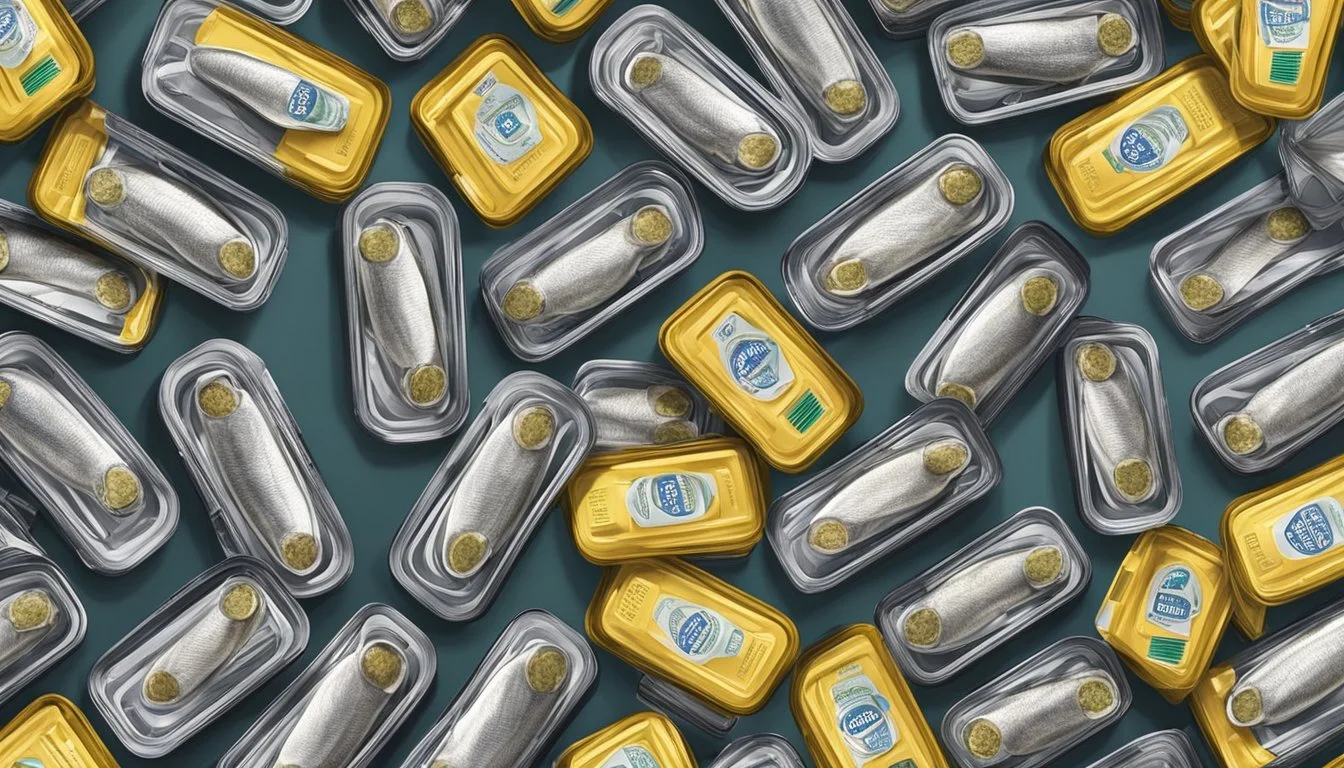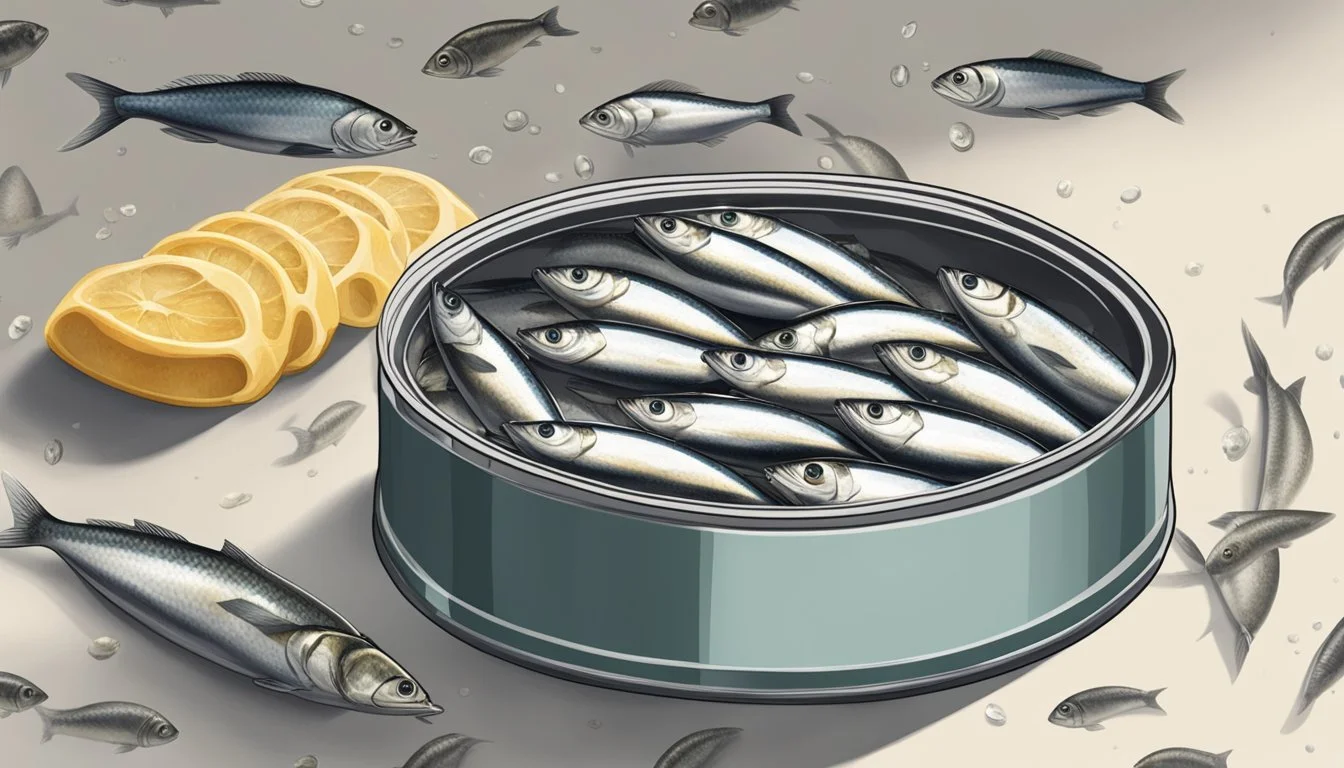How Long Do Sardines Last?
Shelf Life and Storage Tips
Sardines are a popular fish preserved through canning and known for their long shelf life, making them a staple in many pantries. The preservation process allows these small, oily fish to be stored for extended periods without spoiling. Typically, unopened canned sardines can last from two to five years, with the longevity depending on factors such as the manufacturing date and storage conditions. It's integral to observe the 'best by' date provided by the manufacturer as this is a good indicator of when the product is expected to retain optimal quality.
Once a can of sardines is opened, the shelf life decreases significantly. Opened sardines should be refrigerated and ideally consumed within 3-4 days to ensure safety and prevent spoilage. To extend their use beyond this period, opened sardines can be frozen, where they maintain quality for up to three months. When storing opened sardines, transferring them to a covered glass or plastic container can help maintain freshness and contain odors.
Maintaining the quality and safety of canned sardines is straightforward with proper storage. Unopened cans should be kept in a cool, dry place away from sunlight. Consumers should inspect the cans before use, discarding any that show signs of rust, damage, or swelling, as these are indications of potential contamination. When stored and handled correctly, sardines offer a convenient and nutritious option for meals that can be enjoyed well beyond their purchase date.
Understanding Sardines
Sardines are a group of small, oily fish that are rich in nutrients and offer numerous health benefits. Understanding the different types, nutritional value, and health benefits is pivotal for appreciating this nutrient-packed seafood.
Types of Sardines
There are several species commonly referred to as sardines. The Pacific sardine, a prevalent type, is known for its commercial value. Sardines can also include young pilchards and several types of fish in the herring family, closely related to mackerel. Globally, sardines are consumed in various forms – fresh, canned, smoked, and preserved.
Nutritional Value
Sardines are highly nutritious, offering an excellent source of omega-3 fatty acids, which contribute to heart and cognitive health. A typical serving of sardines (1 can or 92grams) provides:
Nutrient Amount Calories 191 Fat 10.45g Protein 22.7g Calcium 35% of RDI Vitamin D 44% of RDI
They are also low in calories considering their high protein content. This nutrient profile supports muscle building and repair, exemplifying sardines as a powerhouse of energy and building blocks for the body.
Health Benefits
Consuming sardines can be beneficial for the immune system, heart health, and bone health due to their rich composition of minerals and vitamins. Omega-3 fatty acids are known to reduce the risk of heart disease, while calcium and vitamin D are crucial for maintaining strong and healthy bones. The protein in sardines aids in repairing tissues and supports immune function. These combined nutrients make sardines a valuable addition to a balanced diet.
Sardine Shelf Life Fundamentals
Understanding the fundamentals of sardine shelf life is critical, as it varies significantly between fresh and canned varieties, and is influenced by a multitude of storage conditions.
Fresh Vs. Canned Sardines
Fresh sardines have a relatively short shelf life, with optimal freshness lasting only a few days. It is imperative that they are stored in a refrigerator at a temperature between 32°F and 38°F to maintain quality. In contrast, canned sardines have a much longer shelf life due to the canning process, which often involves the sardines being packed in oil, water, or salt and can extend their edibility.
Shelf Life:
Fresh: 1-2 days in the refrigerator
Canned: Typically 2-5 years unopened
Factors Affecting Shelf Life
The shelf life of sardines, both fresh and canned, is influenced by several factors. The freshness of sardines when they were caught is crucial for determining their initial quality. For canned sardines, the date of manufacture is an important indicator of expiration date. Further, the storage temperature has a significant impact, and fluctuations should be avoided to preserve shelf life.
Key Factors:
Freshness at capture
Storage temperature
Canning date
Proper Storage Techniques
Proper storage of sardines is crucial for maintaining their freshness and extending their shelf life. From unopened cans to the proper freezing methods, the following subsections provide specific guidelines to ensure sardines are stored under optimal conditions.
Storing Unopened Cans
Unopened cans of sardines should be kept in a cool, dry place away from direct sunlight. The ideal storage temperature is below room temperature but not so cold as to freeze the cans. A pantry or a cupboard often provides the appropriate conditions. It is important to check the expiration date on the cans and use them before this date for the best quality.
Storing Opened Cans
Once opened, any unused sardines should be transferred from the can to an airtight plastic container, and then refrigerated. The sardines should ideally be covered with the oil they came in, or if not available, with olive oil or a mixture of salt and lemon juice to keep them moist and flavorful. Opened cans of sardines can be refrigerated for up to two days.
Freezing Sardines
Sardines can be frozen to extend their shelf life significantly. Prior to freezing, one should clean, and dry the fish. After preparing the sardines:
Place them in a single layer on a tray or plate and freeze them until firm
Transfer the frozen sardines to an airtight packaging or heavy-duty freezer bags to prevent freezer burn
Store in the freezer at a constant 0°F or lower for optimal freshness
Thaw frozen sardines in the refrigerator overnight when ready to use. Avoid refreezing previously thawed sardines to ensure the best texture and taste.
Extending Shelf Life
To maximize the shelf life of fresh sardines, one must keep them at a constant refrigerated temperature. Store them in the coldest part of the refrigerator, preferably on a bed of ice in a perforated pan to allow for drainage. This configuration mimics the storage conditions similar to a fishmonger's display, maintaining the sardines' quality for a longer period.
Identifying Spoilage
When it comes to sardines, detecting spoilage is crucial for food safety. This section outlines how to identify when sardines are no longer safe to eat.
Signs of Spoilage in Cans
Canned sardines can last a long time, but they are not immune to spoilage. Consumers should look for bulging cans, which can indicate the production of gases by bacteria and microorganisms that cause food to spoil. Additionally, when opening a can, one should be aware of any foul smell or the presence of mold, both of which are telltale signs that the sardines have gone bad. Any deviation from the normal appearance, such as a change in color or texture, may also suggest spoilage. If any of these signs are present, it is essential to discard the canned sardines to avoid health risks.
Spoilage in Fresh Sardines
Fresh sardines are more perishable and require careful handling. They should be gutted and cleaned promptly after purchase to minimize the risk of bacterial growth. Recognizing spoilage in fresh sardines involves noting any unpleasant odors, which are not characteristic of fresh fish. The presence of a slimy coat or visible discolorations can also indicate that the sardines are no longer fresh. If any doubt arises about the freshness of sardines, they should be discarded to prevent the ingestion of harmful microorganisms.
Safe Consumption Practices
When consuming sardines, safety is paramount to ensure that the benefits, such as the omega-3 fatty acids sardines provide, are enjoyed without risk. Proper assessment of canned sardines before use and safe handling and preparation of opened sardines are essential.
Assessing Canned Sardines
Before consuming canned sardines, it's crucial to ensure they are safe to eat. Examine cans for any signs of damage, such as bulging, rust, or significant dents, which could indicate potential contamination or spoilage. It’s important to also check the expiry date; while canned sardines have a long shelf life, they should not be consumed past this date for safety reasons.
Handling and Preparing
Once a can of sardines is opened, safe handling and preparation are key to maintaining quality and safety:
Leftover Sardines: Refrigerate any leftover sardines in a sealed container; use them within 2 days for best quality.
Cooking: If cooking sardines, ensure they are cooked thoroughly, which can improve both the taste and safety.
Thawing: For frozen sardines, thaw them in the refrigerator to prevent the growth of harmful bacteria.
Gutting and Cleaning: Fresh sardines must be gutted and cleaned under cold running water before consumption. Practice proper sanitation to reduce risk of foodborne illness.
Lemon Juice and Spices: Adding lemon juice and spices can enhance flavor, but they should only be added during the preparation stage to avoid altering the preservation environment of unopened cans.
By following these guidelines, consumers can safely enjoy the health benefits of sardines.
Incorporating Sardines into Your Diet
Sardines represent a nutrient-rich seafood choice that can easily be introduced into a variety of meals. From cooking methods to flavor combinations, this section provides a practical guide for those looking to add sardines to their diet.
Selecting Fresh Sardines
The first step in enjoying sardines is to select fresh fish. Fresh sardines should possess clear eyes and a shiny surface with a mild, not overpowering, scent of the sea. When shopping for sardines, one should look for those that are firm to the touch and appear moist rather than dry.
Buying Tips:
Eyes: Look for bright, clear eyes indicating freshness.
Skin: Seek out shiny and intact skin without blemishes.
Smell: Fresh sardines should have a sea-breeze scent, not a fishy odor.
Sardine-Inspired Recipes
Sardines can be the star in a multitude of recipes, fitting perfectly into Mediterranean cuisine famed for its healthy attributes. They are versatile enough to be featured in pasta dishes or as a protein boost in salads. Due to their strong flavor, sardines are often paired with robust Mediterranean flavors such as lemon juice, olives, and tomatoes.
Simple Recipe Ideas:
Pasta with Sardines: Tossed with garlic, olive oil, and parsley.
Sardine Salad: Mixed with leafy greens, lemon juice, and a hint of chili.
Enhancing Flavors
To best enjoy sardines, it's important to know how to enhance their flavors with the right accompaniments. Lemon juice and olive oil are classic additives that can brighten the taste of sardines. When cooking, one can also explore the use of various spices to complement the rich taste of the fish.
Flavor Pairings:
Lemon Juice: Adds zest and cuts the richness of sardines.
Olive Oil: Offers a smooth counterpart to the distinct flavor of sardines.
Spices: Mustard (how long does mustard last?), black pepper, or herbs can add depth to the sardine's taste.
By understanding how to select, prepare, and flavor sardines, one can seamlessly integrate this nutritious fish into their diet, benefiting from its rich taste and health perks.







